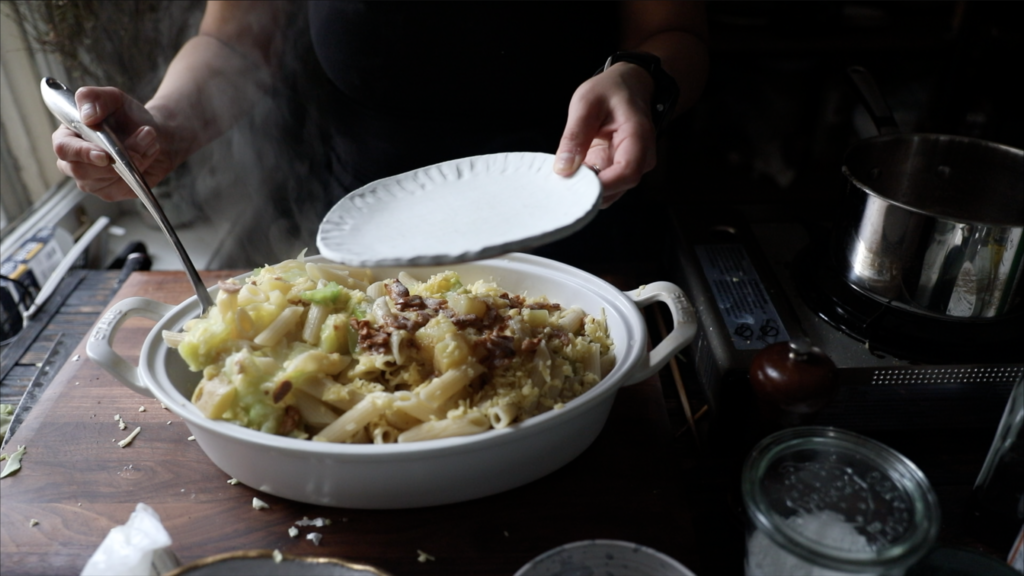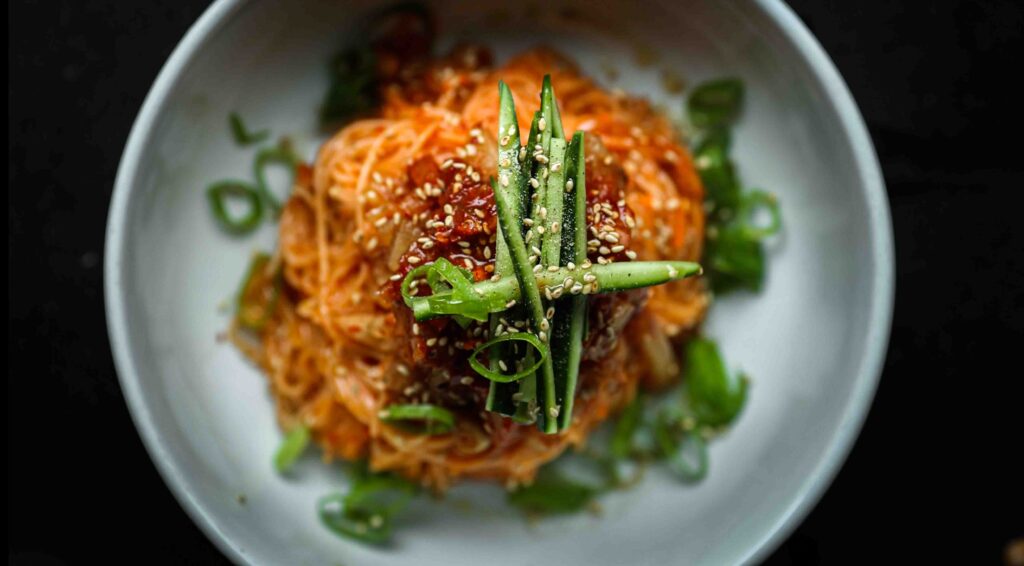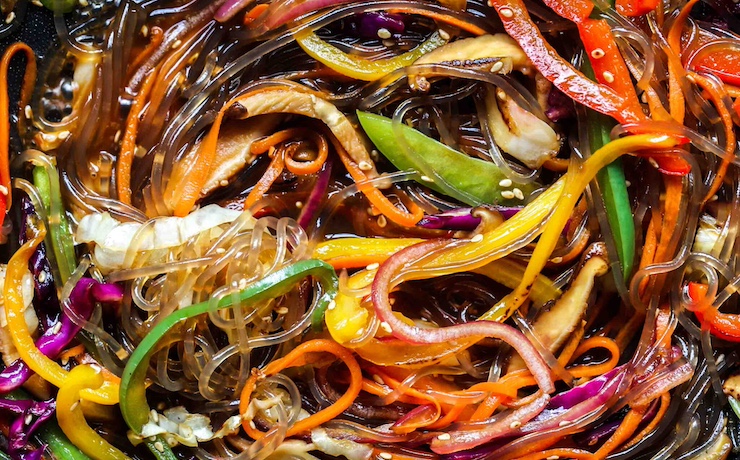Spaghetti Aglio e Olio: The PERFECT 6-Ingredient Pasta Recipe.

Flavorful.
Low-labor.
Dairy-free.
Pasta.
If you’ve never had aglio e olio before, boy are you in for a TREAT!! This classic Italian pasta dish is probably one of my all-time favorites (it’s a toss up between this and pasta pomodoro) and guess what? It’s traditionally vegan.
And, to make sure I’m doing this dish justice, I consulted mio cugino Italiano, Roberto, during my most recent visit to Rome. This recipe comes directly from him!
So, buckle up, and mangiamo!

Disclaimer: Some of the links in this post may be affiliate links for products I use and love. If you make a purchase after clicking one of those links, I may earn a small affiliate commission, perhaps enough to buy some extra gochujang or gochugaru 🙂
What is Aglio e Olio?

A direct translation of aglio e olio is “garlic and oil.” These are the two main ingredients to this pasta. Originating from Naples, Italy, like so many of my favorite dishes, aglio e olio was designed to offer a satisfying, hearty, but very low-cost meal. There are a lot of varieties endemic to each region, but, at bottom, it is supposed to be a very simple dish. Moreover, it’s traditionally prepared without cheese (surprise surprise!) and therefore, already vegan (assuming you use dried spaghetti–which most people do anyway). If you use gluten-free pasta, this dish is also gluten-free!
Is it always made with spaghetti? Traditionally, yes. I’ve never seen this dish made with any other pasta. Why? The thickness and shape of spaghetti makes it easy for the sauce to “stick.” That’s not to say you can’t make this with a different kind of pasta; but, it may be harder to achieve the emulsification with a penne or a fusilli, that’s all!
Broth or No Broth in Aglio e Olio?
I’ve eaten a lot of aglio e olio and they usually contain the same five ingredients. However, there appears one particular feature that divides the pasta I’ve had: broth or no broth. Some versions of aglio e olio are steeped in a golden, garlicky broth. Others are coated with a flavorful, buttery sauce. Both are absolutely delicious.
I asked Roberto which one he makes: the “no broth” kind. So, that is the version we have here!
Key Ingredients and Notes on Substitutions for Spaghetti Aglio e Olio Recipe.
This spaghetti aglio e olio recipe has only five ingredients, so there isn’t much room (if any) for substitution. But let’s take a good look at each in turn and discuss:
Spaghetti.

As I said earlier, the traditional aglio e olio recipe starts with spaghetti, largely because its shape and thickness lends itself well to such a simple sauce. Roberto recommended the spaghetti from Barilla’s “Al Bronzo” collection. The pasta in this collection is made using really high quality wheat and dried in such a way as to “catch” the sauce way more efficiently. Honestly, though, use whatever spaghetti you like best!
That said, if all you’ve got on hand is a box of penne or macaroni, that’s not a good enough reason not to try this recipe! This recipe will be good with just about any pasta (rigatoni might be pushing it…), so go with what you got!
Extra Virgin Olive Oil (Olio).

The “olio” in aglio e olio is extra virgin olive oil. Because there are so few ingredients in this pasta, you will want to make sure you use a delicious tasting extra virgin olive oil–the kind you use for salad dressings and dipping your bread. I prefer going with local olive oils, if I can, but honestly, go with whatever brand you’ve relied upon in the past.
For the same reason, I would say that extra virgin olive oil cannot be substituted here with a different kind of oil or vegetable broth (which is my go-to when I’m trying to make a recipe oil-free). Oil is literally in the name of this dish, after all, speaking to how important a component it is!
Red Pepper Flakes (Peperoncino).
These are not the banana peppers you see cozied up with your vegan hot dog (at least if you’re in Chicago). These are the red chili flakes you get in that square, paper packet when you order pizza! These will add just a hint of heat to your aglio e olio and, according to Roberto, is one of the five ingredients to this iconic pasta dish.
If you don’t have these red pepper flakes on hand, though, then I would just omit them. I wouldn’t try substituting paprika or something, as that will burn and create a weird texture to the sauce. If you still want the heat, better to add lots of cracked black pepper as garnish at the end!
Garlic (Aglio).

The word “aglio” means garlic. Is it a surprise that this classic Italian dish contains garlic? I will say, I was quite surprised at how little garlic Roberto uses for his recipe. But, it goes to show–I’d been making it all wrong before. The way Roberto infuses the oil with garlic proves that you really only need a little and it will go a long way–when prepared properly. In keeping with how aglio e olio was originally devised as a dish for those with little disposable cash, it makes sense that we try and stretch the ingredients as far as they’ll go!
Substitutions for garlic? As you might have guessed: none.
Salt (Sale).

Because there are so few ingredients, aglio e olio relies on properly salted pasta water for full flavor. Interestingly, Roberto did not separately salt his pasta after incorporating the oil and garlic. He said it wasn’t necessary and he was absolutely right.
Flat Leaf or “Italian” Parsley (Prezzemolo).

According to Roberto, “you need” flat leaf or Italian parsley for aglio e olio. And, I have to agree. You need some kind of fresh green that will cut through the heaviness of the garlic and oil. Parsley does precisely that. If you don’t have flat leaf parsley, you should be fine with curly parsley.
Can you substitute with a different herb? If you must, I would stick with something that has a similar flavor profile to parsley, like chervil. You could also go with something more neutral, like arugula or spinach. I would not try to substitute in something like cilantro–it looks similar, but will create such a different flavor profile for this recipe, you’ll essentially be making a totally different dish.
Step-by-Step Instructions for Making Spaghetti Aglio e Olio.
While there are only a handful of ingredients, there are some very specific steps for making the perfect aglio e olio.
Step 1.
To a medium pot, add your pasta water and bring it to a gentle boil.
Step 2.
Once your pasta water is boiling, add olive oil, red pepper flakes, and sliced garlic to a large pan–one large enough to accommodate an entire box of spaghetti. Place the pan on top of the pot of boiling water, in lieu of over an open flame. This will ensure that your oil picks up the flavors and the heat without burning the garlic and the red pepper flakes. You will see little bubbles start to form after about 15 minutes. Remove the pan from the top of your pasta water pot and add both salt and spaghetti to your pasta water. Cook for 1 minute less than the allotted cooking time on the box.

Step 3.
While your spaghetti is cooking, put your pan of oil and garlic on the lowest setting of heat. Continue to cook while your pasta cooks. By the time your pasta is ready, your garlic should be slightly brown around the edges.

Step 4.
If you like the texture of the toasted garlic, leave it in the oil. Otherwise, you can fish them out. Drain the pasta and place it in the pan with the garlic and chili infused oil. Add chopped parsley. Using tongs, vigorously stir the pasta into the oil over low heat for about 1 minute. The agitation from stirring the pasta over the heat, together with the fat from the oil, is what will cause everything to come together in the most delightful way. So when I say “vigorously,” I mean vigorously!
Serve with an extra drizzle of olive oil or a crack of black pepper. Done!

Frequently Asked Questions.
What is aglio e olio?
Aglio e olio literally translates into “garlic and oil,” and refers to a classic Italian pasta dish originating from Naples, made out of spaghetti and a garlic infused oil.
Is aglio e olio vegan?
Generally, spaghetti aglio e olio is a great dish for those following a vegan or plant-based diet. Most recipes do not call for cheese and can be made with dried (egg free) pasta.
Want More Pasta and Noodle Recipes?
Recipe Card.

Spaghetti Aglio e Olio.
Ingredients
- 1/4 cup extra virgin olive oil
- 1 tbsp red pepper flakes
- 2 cloves garlic, sliced into thin slices
- 2 tbsp course sea salt
- 1 lb dried spaghetti
- 1/4 cup chopped flat leaf parsley
Instructions
- Bring a medium pot of water to a gentle boil.
- Once your pasta water is boiling, add olive oil, red pepper flakes, and sliced garlic to a large pan–one large enough to accommodate an entire box of spaghetti. Place the pan on top of the pot of boiling water, in lieu of over an open flame. This will ensure that your oil picks up the flavors and the heat without burning the garlic and the red pepper flakes. You will see little bubbles start to form after about 15 minutes. Remove the pan from the top of your pasta water pot and add both salt and spaghetti to your pasta water. Cook for 1 minute less than the allotted cooking time on the box.
- While your spaghetti is cooking, put your pan of oil and garlic on the lowest setting of heat. Continue to cook while your pasta cooks. By the time your pasta is ready, your garlic should be slightly brown around the edges.
- If you like the texture of the toasted garlic, leave it in the oil. Otherwise, you can fish it out. Drain the pasta and place it in the pan with the garlic and chili infused oil. Add chopped parsley. Using tongs, vigorously stir the pasta into the oil over low heat for about 1 minute. The agitation from stirring the pasta over the heat, together with the fat from the oil, is what will cause everything to come together in the most delightful way. So when I say "vigorously," I mean vigorously!
Did you like this recipe? If so, please leave a rating and share it!
















1 tbsp. of red pepper flakes seemed excessive. I used 1/2 tsp. and it had more than enough heat. It was very good and even better the next day. I would make again.